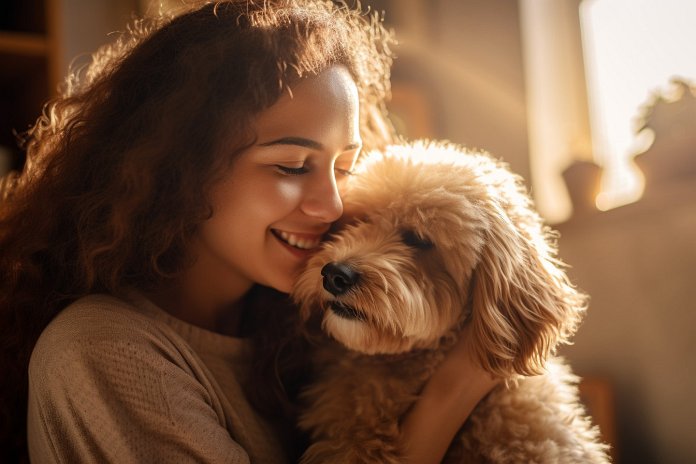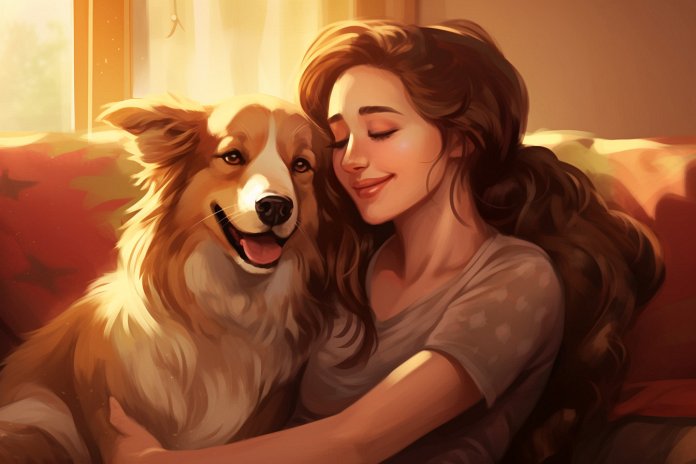
Kisses have always been a sign of affection among humans. We kiss our partners, family members, and children to show love. Even in some countries, kissing is seen as a greeting and a positive gesture. Animal lovers also kiss and cuddle their pets, like cats and dogs, as a natural instinct. But do dogs understand and feel kisses?
Signs of Dogs Feeling Kisses
When you kiss your dog, you may notice signs that indicate they understand it as a gesture of affection. As puppies, dogs may not recognize kisses, but they can feel them. However, as they grow older, they associate kisses and cuddles with you being happy with them. They learn that kisses are a good sign.
You may see your dog jump up and try to lick you when you kiss them, which is their way of showing affection. They may also become excited and run around with wagging tails.
Many dogs will look into your eyes when you kiss and cuddle them, showing how much they trust you. When owners use a cutesy or gentle tone while kissing their dogs, the dogs learn to associate kisses with that tone. They respond accordingly and often show affection back in their own way.
Your dog’s body language when you kiss them will indicate that they know it’s a sign of affection. Dogs may wag their tails, look alert, lick your hand or face, act excited, or run around. Each dog has its own way of responding, but you can tell from their body language if they enjoy the kisses.
Young puppies may not show any signs of recognition because they haven’t learned to associate kisses with affection yet. But as they get older, dogs tend to respond with signs of affection like licking and jumping up. It varies based on the dog’s personality.
Body Language
Signs that your dog enjoys being kissed include being alert, tilting their head, wagging their tail, and licking.
Other signs to watch for include acting excited, nuzzling up to you, licking your hand or face, and jumping up.
The History of Dogs and Kisses
Throughout history, kisses have been associated with love, affection, and greetings among humans. However, dogs may not have received kisses and cuddles in the past because they weren’t considered part of the family. But nowadays, dogs are considered family members and receive the same affection and love.
Research has helped experts understand how dogs respond to human gestures. While dog communication is different from human communication, dogs have learned to understand our communication over the centuries. Dogs respond to the tone of our communication, and if kisses are accompanied by a happy and gentle tone, they associate that gesture with happiness.
The Science of Dogs and Kisses
When dogs lick themselves or each other, it releases endorphins, similar to how humans feel when they kiss. Dogs don’t realize this because they don’t understand kisses. However, they are used to being licked by their mother and other dogs, so kissing is the closest a human can come to replicating that experience.
Training Dogs to Kiss
It’s a good idea to start kissing and cuddling your dog as a puppy. This helps them get used to kisses and being handled, which is important for their overall comfort. It can also strengthen the bond between you and your dog.
If you adopt an older dog, it may be challenging to start showing affection later in their life, especially if they have trust issues due to being a rescue or abused dog. However, with patience and gradual kisses and cuddles, you can gain their trust.
To teach your dog to kiss you, you can hold a treat in your hand and encourage them to lick it. Use the word “kisses” or a similar word while they lick your hand, creating a link between the word and the action. You can also teach them to kiss or bump your nose by holding a treat close to your nose. Eventually, you won’t need treats, and just saying the word “kisses” will be enough to prompt the action. It’s a simple and effective way to train your dog to kiss you.
“Dogs understand kisses as a sign of affection and learn to associate them with happiness and trust.”

Tips & Things to Know
1️⃣ Dogs can understand and feel affection when you kiss them. As they get older, they associate kisses and cuddles with you being happy with them, and they may show signs of affection like licking, jumping up, or wagging their tail.
2️⃣ Dogs respond to tone when it comes to communication with their owners. If your kisses are accompanied by a pleasant and gentle tone, they will start associating that particular gesture with happiness.
3️⃣ You can train your dog to kiss you by holding a treat in your hand and encouraging them to lick it. Once they start doing this, use a word like “kisses” to link it with licking. You can also teach them to bump your nose by holding a treat close to your nose. Gradually, they will understand the cues and respond to your verbal command.
Frequently Asked Questions, Answered ✅
1. Do dogs understand that kisses are a sign of affection?
– Yes, as dogs get older, they associate kisses and cuddles with their owner being happy with them, and they learn that kisses are a good sign.
2. How do dogs show affection when they are being kissed?
– Dogs may jump up and lick their owner, become excited and run around with their tail wagging, and look into their owner’s eyes. They may also exhibit other signs of affection such as wagging their tail, looking alert, and nuzzling up to their owner.
3. Did dogs in the past receive kisses and cuddles from their owners?
– In the past, dogs were not considered part of the family and may not have received kisses and cuddles from their owners. However, in modern times, dogs are considered part of the family and receive the same affection and love.
4. How do dogs respond to kisses from their owners?
– Dogs respond to the tone of their owner’s voice when being kissed. If the kisses are accompanied by a pleasant and gentle tone, dogs will associate that gesture with happiness.
5. Can dogs be trained to kiss their owners?
– Yes, dogs can be trained to kiss their owners. Using treats, owners can encourage their dogs to lick their hand or nose and associate the word “kisses” with the action. Eventually, the treats may not be necessary, and the dog will understand what is expected when the word “kisses” is used.